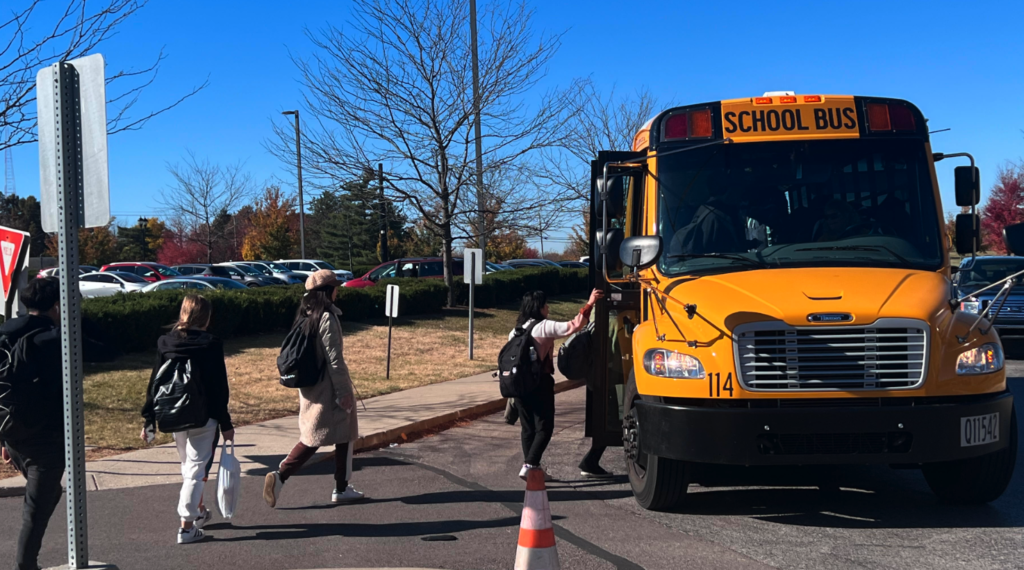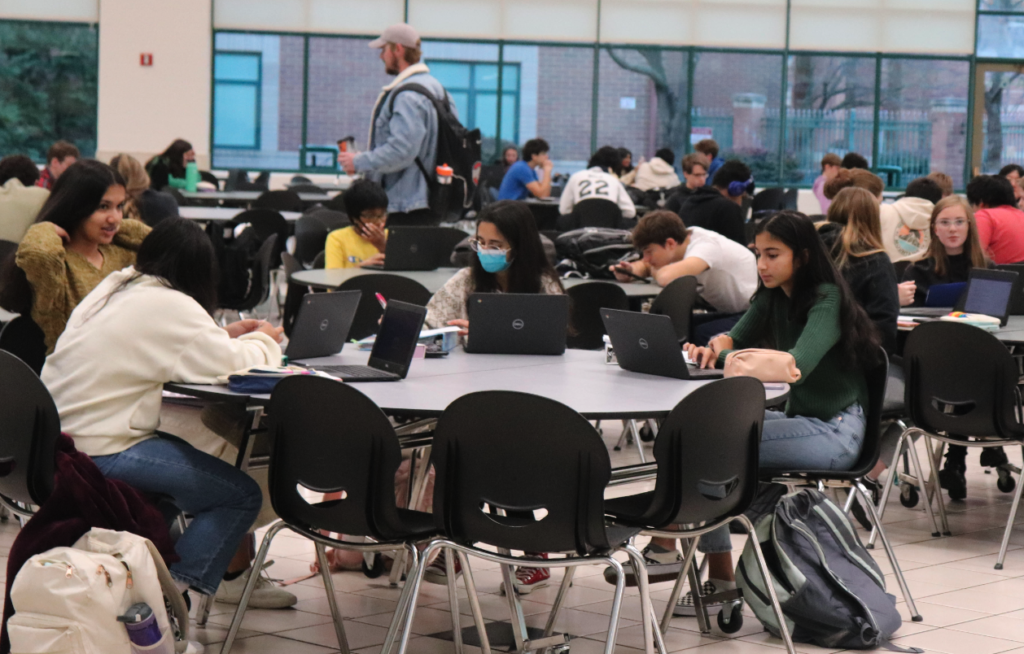Students feeling impact of shortages

Megan Lee | The Chronicle
Staff and students, please pardon the interruption.
This inevitable announcement has defined the end of every seventh period this school year for Mason High School (MHS) bus riders. Buses that have no drivers are announced by their numbers, and the students who ride them must wait at the office until transportation can be arranged.
This instability and lack of reliable transportation create time-consuming issues for students and parents who rely on buses. Instead of consistently walking to their assigned bus number at the end of each school day, many bus riders’ schedules are now uncertain due to a severe shortage of bus drivers in the Mason City Schools District. Sophomore Ayesha Ahmad rode bus 104 and said she had not had a permanent bus driver since August.
“[Our bus driver] told us she wasn’t coming back until October, so ever since, we’ve had different subs,” Ahmad said. “It’s October, and she still isn’t here.”
Every seventh bell, Ahmad waits for the dreaded announcement that will tell her to go wait at the front of the building since there is no bus to take her home. With varying drivers every day, Bus 104 takes a new route every morning and afternoon. Ahmad said this makes it challenging to
coordinate her schedule both before and after school because she does not know when her bus will arrive.
“Every time we get a new sub, we get home at a different time,” Ahmad said. “The bus could come two minutes late or two minutes early – it gets exhausting.”
Although MHS students are burdened by the inconsistencies in their daily transportation, staff members are working to get these issues resolved. Transportation Security Administration (TSA) Supervisor Mark Murzynowski said he works to arrange bus schedules and office roles in order to get students home.
“We start every single day 11 [buses] short,” Murzynowski said. “So we utilize all of the subs that we have, as well as any of our office people or mechanics that can drive.”
Although the TSA had to explore unconventional options to acquire bus drivers, they are constantly searching for a more permanent option. Murzynowski said he interviewed 31 potential bus drivers; four are currently in training and another nine are waiting on their licensing and paperwork.
“Fortunately, we have not canceled a single route yet this year,” Murzynowski says. “Other districts are canceling routes and forcing parents to take children to and from school, [but] we have not done that.”

The shortage of bus drivers is not the only problem facing MHS students. Junior Brooklynn Golden said that on the day of her latest chemistry test, there was no teacher in the room when she walked in.
“All her other classes had a sub that day,” Golden said. “When no one came in after 10 minutes we knew something was up.”
Without a substitute to administer the test, Golden said her class was the only class period that was unable to take it. In the days following, Golden said her class experienced being a day behind the students in other bells.
“We just wrote on the board that we didn’t have a sub,” Golden said. “We didn’t really know what to do so we treated it as a study hall.”
Even though administrative staff members have had a hard time filling the need for substitute teachers, behind them is a group of applicants hoping to be added to the MHS staff. Chief Talent Officer (CTO), Tonya McCall said that in the past couple of months she has seen an increase in applications.
“[Each] department ultimately decides who they want on staff,” McCall said. “However, all hiring must come through the Human Resources Department first.”
Since each application has to go through McCall’s department first, she said that the processing time for each individual application is long. However, Mason is not the only district that is facing staff shortages.
“It is definitely a regional issue,” McCall said. “[We] have regular contact with Southwest Ohio HR directors and that is one thing that we talk about a lot.”
Even though there are enough applicants, McCall emphasizes the fact that they are trying to find the best-fit people for the job. Often, this will include utilizing student teachers and having them gain experience through subbing.
“We’re trying to tap into all of the resources that make the most sense for us,” McCall said. “What we’re not going to do is just let anybody [substitute], that can be just as harmful as not having enough people.”
While there has been a struggle for McCall and other CTO’s to hire qualified candidates, the Ohio state government is working to make the process easier. To alleviate the stress of substitute teacher shortages, the Ohio state legislature passed a temporary policy that allowed anyone 18 and older with a high school diploma to work to pursue a Substitute Teaching License. However, schools have still had difficulty finding substitute teachers.
One substitute teacher, former MHS chemistry teacher Barbara Shuba, decided two years ago that she wanted to return to teach as a substitute teacher after her retirement.
“Not having enough subs was becoming a problem even prior to Covid-19,” Shuba said. “I’d say it [was bad] last year, and it seems like it’s already worse this year.”
MHS currently utilizes an app called Frontline, where teachers can mark days they will be absent and substitutes can sign up to take their slots based on their availability. Shuba said that even before she stopped teaching, she noticed she was having problems finding people to cover her classes. Since 2020, when she became a substitute teacher, Shuba said the demand for subs has continued to grow.
“You can either be assigned if somebody reaches out to you or you can select a job listed,” Shuba said. “If you are already assigned to a job, no options will appear.”
However, when it comes to unprepared absences such as sick days, it is difficult for teachers to get subs for their classes. Shuba said that not having enough substitute teachers damages the experience of the students she chooses to work with.
“When we decide whether or not we want to work, especially when we are needed, it doesn’t just affect one person, but a whole district,” Shuba said.
Photos by Khusbu Patel and Megan Lee
